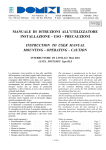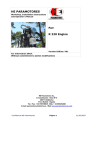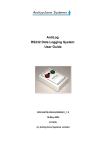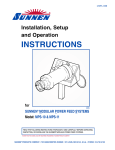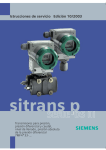Download manuale di istruzioni all'utilizzatore installazione – uso
Transcript
Indicatori di livello Interruttori di livello Strumenti pneumatici DOMIZI Snc, Te l +39-011-9457022 V ia Pole sine 15, Fa x +39-011-9457021 Level indicators Level switches Pneumatic instruments 10020 CAMBIANO, TOR INO, ITALY E -ma il : sa le [email protected] w w w .domizi.com M (DIL) Settembre 05 MANUALE DI ISTRUZIONI ALL’UTILIZZATORE INSTALLAZIONE – USO – PRECAUZIONI INSTRUCTION TO USER MANUAL MOUNTING – OPERATING – CAUTION INDICATORI DI LIVELLO LEVEL INDICATORS Serie : DIL Lo strumento viene prodotto in base alle specifiche dell’acquirente e nel pieno rispetto delle Norme nazionali e internazionali sulla Qualità e Sicurezza. Viene consegnato dalla fabbrica solo dopo aver superato i controlli intermedi ed il collaudo finale; viene sempre accompagnato dal presente Manuale generale, dal Disegno tecnico che ne elenca le prestazioni specifiche, e dal Certificato di prova che ne attesta il collaudo individuale. È pertanto pronto per essere installato sul serbatoio. Le operazioni di installazione e di manutenzione dovranno essere eseguite solo da personale adeguatamente preparato allo scopo. Se vengono rispettati i dati riportati in questi documenti, lo strumento è certamente in condizione di assicurare prestazioni di alta qualità e di lunga durata. Si consiglia perciò di porre la massima attenzione alle istruzioni che seguono, integrandole con tutto ciò che proviene dalla propria esperienza e dal buon senso generale. The instrument is manufactured on the basis of the purchaser’s specifications and in the total conformity of national and international standards about Quality and Safety. It is delivered by the factory only after having passed positively intermediate and final tests; it is always accompanied by the present general Manual, by the technical Drawing listing the specific performances of it, and by the Test certificate stating the individual final test of it. Consequently it is ready to be installed on the vessel. All the installing and maintenance operations shall be made only by skilled personnel. If purchaser effects the technical data reported in these documents, the instrument is certainly in condition of assuring high quality and long life performances. We recommend to pay the max attention to the following instructions, integrating them with all that may come from your own experience and general good sense. Indice degli argomenti : • Funzionamento e Targhe . . . . . • Installazione : montaggio . . . . . • Messa in funzione . . . . . . . • Regolazione . . . . . . . . . • Manutenzione: smontaggio/montaggio • Problemi e soluzioni . . . . . • Disegno specifico dello strumento . . Table of contents : • Operation and Plates . . . . . . • Installation : assembling . . . . . • Start up . . . . . . . . . • Adjustment . . . . . . . . • Maintenance: dismantling/assembling • Problems and solutions . . . . • Specific drawing of instrument . . . . . . . . . . Pag. 2 Pag. 3 Pag. 5 Pag. 5 Pag. 6 Pag. 6 Pag. 12 1 – M (DIL) Page 7 Page 8 Page 10 Page 10 Page 11 Page 11 Page 12 PRINCIPIO DI FUNZIONAMENTO Serbatoio Gli Indicatori DIL sono progettati per indicare il livello del liquido contenuto in un serbatoio ed, eventualmente, dare un segnale d’allarme quando viene raggiunta una certa altezza. Funziona sul principio della trasmissione magnetica tra il galleggiante interno e la scala indicatrice esterna : durante i suoi movimenti verticali, il campo magnetico del galleggiante interagisce con quello dei rullini bicolore che si trovano entro la scala indicatrice, e li fa ruotare di 180°. A mano a mano che il livello del liquido sale nel serbatoio, i Indicatore di Livello rullini ruotano in modo da mostrare il lato rosso e nascondere quello bianco.Accade il contrario quando il livello ridiscende. Grazie a questo funzionamento, si hanno molti vantaggi : Scala (A) La trasmissione del livello dal liquido alla scala indicaindicatrice trice è realizzata senza alcun contatto fisico. (B) Di conseguenza, anche se il liquido è sporco ed oleoso, la scala indiGalleggiante catrice rimane sempre leggibile e non richiede pulizie perioFlange di con magneti attacco diche. (C) La scala indicatrice non ha zone morte, né nei tratti intermedi né in quelli terminali e risulta leggibile al Allarmi 100% della sua altezza, anche da notevoli distanze e sotto angoli molto ampi. (D) Sulla scala indicatrice è possibile montare un Sensore di livello che trasmette a distanza un segnale elettrico di 4÷20mA. (E) Sulla scala è possibile Corpo anche montare uno o più Allarmi per segnalare ad es. il livello Max o Min o intermedio; è possibile aggiungerli Flange di anche in un secondo tempo, e modificare a piacere l’altezza ispezione di intervento. (F) Grazie alla possibilità degli allarmi, lo strumento può svolgere la doppia funzione di Indicatore e di Interruttore di Livello. In questi strumenti il liquido sotto controllo ed i suoi vapori sono confinati nel corpo stagno anche quando sono sotto pressione e ad alta temperatura, e non vengono mai a contatto né con l’esterno, né con la scala indicatrice : infatti la trasmissione del movimento del galleggiante dal liquido alla scala indicatrice è affidata unicamente al campo magnetico. Viene così annullato ogni rischio che si inneschino esplosioni di gas pericolosi. TARGA SUGLI INDICATORI DI LIVELLO SIGNIFICATO : • Codice dello strumento • Sigla assegnata dall’acquirente • Num. serie dello strumento, Anno di produzione • Pressione del fluido (massima o di progetto) • Pressione e Data di collaudo • Temperatura di Processo e Ambiente • Peso specifico del fluido • Volume del corpo strumento • Allarmi elettrici : quantità • Codice, Versione (antideflagrante, normale) • Portata elettrica del contatto • Marchio CE • Ente Notificato che sorveglia la produzione • Apparecchio per zone con atmosfera potenzialmente esplosiva • Gruppo II, Categoria 1/2 • Miscela esplosiva : Gas • E = Norme europee armonizzate • Ex = Protezione da rischio di esplosione • dc = Custodia a prova di esplosione a sicurezza costruttiva • IIC = Gruppo dei gas / T… = Classi di temperature • Ente Notificato : KEMA /Anno di certificazione 2005 • Numero di certificazione • Versione senza allarme elettrico • Nome e indirizzo del fabbricante • Conforme alla normativa PED 97/23/CE LEVEL INDICATOR INDICATORE DI LIVELLO Code : ____________ Tag : ______________ Serial No : ____________ Production year : ____ Pressure : _______ bar Max Project Tested at : ______ bar, in date : ___/ ______ Proc.. T° min/max : ______ / ______ °C Amb. T° min/max : ______ / ______ °C Specific gravity of fluid : ______ kg/m³ Chamber volume : ____dm³ 0948 PED Electric alarms : ____ pcs - Code _____ Version : EEx d Standard - Load : As marked on the above Alarm switch 0496 II 1/2 GEEx dc IICT.. KEMA 05ATEX2124 (or II 1/2 G c T..) (or 05ATEX2126) www.domizi.com [email protected] Via Polesine 15 10020 Cambiano, Torino, Italia Tel.+39 011 945.70.22 Fax +39 011 945.70.21 NOTA – Nel caso di Indicatore di Livello operante a temperature tali da costituire pericolo di scottature per la persona, viene aggiunta una targa di avvertimento sullo strumento. 2 – M (DIL) INSTALLAZIONE Tutte le operazioni di ricezione e installazione dello strumento, anche se affidate a personale di lunga esperienza, devono essere eseguite con i criteri della massima sicurezza, per evitare incidenti alle persone ed alle cose. Disimballo dello strumento Il trasporto fino alla destinazione finale, l’apertura della cassa di imballo ed il prelievo dello strumento dalla cassa deve avvenire sempre con il criterio della salvaguardia dell’incolumità e sicurezza delle persone, e sempre e con l’ausilio di appropriati mezzi di sollevamento, di guanti, occhiali, scarpe e vestiti previsti dalle Norme di Sicurezza. Anche se lo strumento non presenta sporgenze o ruvidità tali da provocare tagli ed abrasioni, è normale prudenza maneggiare tutto con molta cura e attenzione. Collegamenti meccanici Si raccomanda di operare sempre con la protezione di guanti, occhiali, scarpe e vestiti previsti dalle apposite Norme di Sicurezza, e di usare sempre gli utensili più adeguati allo scopo. Tutte le operazioni dovranno essere eseguite solo da personale adeguatamente preparato allo scopo. In particolare, per collegare lo strumento al serbatoio, bisogna : - chiudere le valvole di intercettazione, in modo da interrompere il flusso del liquido da e verso il serbatoio; - affacciare lo strumento ai punti di collegamento dell’impianto e poi fissarlo; si raccomanda di installarlo in posizione verticale e ad almeno 1m di distanza da sorgenti elettromagnetiche, per evitare possibili interferenze. Bisogna adoperare tiranti, dadi, guarnizioni ed altri componenti di tipo adeguato alle prestazioni richieste dall’impianto, e serrare i tiranti sulle flange con chiave dinamometrica opportunamente tarata a seconda di quanto richiesto dal costruttore delle flange. Bisogna operare con la massima attenzione e controllare infine anche la tenuta dei collegamenti eseguiti, allo scopo di evitare il rischio di successive perdite di liquidi in pressione, corrosivi, o caldi/freddi, e perciò potenzialmente pericolosi per la salute umana e per l’ambiente (esplosioni e incendi). Collegamenti elettrici Si raccomanda di operare sempre con la massima prudenza, per evitare pericolose scariche elettriche sulla persona e anche danni potenzialmente ingenti sia all’impianto sia all’ambiente, come esplosioni ed incendi. L’impianto elettrico, come d’altra parte tutto il resto dell’impianto, dovrà essere realizzato solo da personale qualificato che agirà sul circuito solo dopo aver tolto tensione e dopo essersi accertato che nell’ambiente non vi è atmosfera esplosiva; dovrà impiegare solo materiale certificato e adeguato alle esigenze dell’impianto (ad es. materiale stagno, antideflagrante, etc). Una volta finiti i collegamenti, dovrà ripristinare le protezioni elettriche e meccaniche, in modo da evitare contatti accidentali con parti sotto tensione. Se sono presenti, collegare i dispositivi elettrici, facendo in modo che : • Il Sensore di Livello venga fissato con le viti in dotazione lungo il fianco dell’Indicatore DIL ed alla stessa altezza della Scala indicatrice. Nel caso di collegamenti molto lunghi, si raccomanda di usare un cavo schermato con fili di almeno 0,75mm² e con schermo collegato a massa ad una sola estremità. Altre informazioni più dettagliate sono allegate al dispositivo. • L’Interruttore magnetico venga fissato lungo i fianchi della Scala indicatrice all’altezza a cui si desidera l’intervento; si tenga presente che il dispositivo commuta quando il magnete del galleggiante passa in corrispondenza della linea marcata “Switchpoint”. Il dispositivo racchiude un contatto reed, con 1 circuito in deviazione SPDT (Single Pole Double Throw) con le portate elettriche elencate nella tabella della pag. seguente. - Si raccomanda di usare fili di almeno 0,75mm² tra l’Interruttore ed il carico, per evitare cadute di tensione. - Se il carico non è resistivo, si raccomanda un circuito di protezione di quelli mostrati nella pagina seguente. - Si raccomanda un relé di protezione per allungare la vita all’Interruttore. • Il carico elettrico non sia mai superiore a quello marcato sui dispositivi. Se è possibile, si faccia in modo che l’intervento scatti sia quando il galleggiante va nella posizione di intervento, sia nel caso che dovessero capitare eventuali anomalie nel circuito elettrico (ad es. rottura del cavo, etc); in tal modo la segnalazione sul quadro elettrico attirerà l’attenzione dell’operatore per una riparazione più tempestiva. • Durante le prime prove di collaudo elettrico si raccomanda di tenere scollegati i circuiti utilizzatori, per evitare di provocare danni a persone ed a cose. 3 – M (DIL) SENSORE DI LIVELLO Distanza 10mm tra 2 interruttori Blu Nero Marrone INTERRUTTORE MAGNETICO Schema elettrico Blu Nero Marrone Punto di commutazione “Switchpoint” L’ Interruttore magnetico fornito con l’Indicatore di Livello può essere uno delle seguenti versioni. Tipo 1 Contatto SPDT bistabile Corpo Temperatura Conformità Applicazioni In argento, portata : Ampolla reed in un corpo + 90°C max Impianti con fluidi che non • 2÷250Vac – 1A – 60VA d’alluminio, cavo 1m in formano miscele potenzial• 2÷250Vdc – 0,5A – 30W PVC 3×0,75mm² + massa. mente esplosive. D2 Durata nominale : Direttive : • 10.000 manovre Stagno IP65. 73/23/CEE + 93/68/CEE In argento, portata : Ampolla reed in un corpo + 150°C max Impianti come sopra, ma • 2÷250Vac – 1A – 60VA d’alluminio, cavo Silicone per temperature più elevate. • 2÷250Vdc – 0,5A – 30W 3×0,75mm² + massa D3 Durata nominale : lunghezza 1m. Direttive : • 10.000 manovre Stagno IP65. 73/23/CEE + 93/68/CEE In argento, portata : Ampolla reed in un corpo + 90°C max Impianti con fluidi che • 2÷250Vac – 1A – 60VA d’alluminio, cavo 1m in possono formare miscele • 2÷250Vdc – 0,5A – 30W PVC 3×0,75mm² + massa. potenzialmente esplosive D6 Durata nominale : Stagno IP68 Direttive : (*). Antidefl. EEx dc IIC T6÷T3 • 10.000 manovre 73/23/CEE + 93/68/CEE (*) – Negli impianti con rischio di esplosione viene impiegata anche la barriera a sicurezza intrinseca tra il contatto di allarme ed il circuito utilizzatore, perché questa assorbe una corrente molto bassa (pochi milli-Ampere e pochi Volt) e tale da non creare scintille pericolose e fonte di innesco efficace. In questo caso viene usato un allarme con contatto in oro, perché rimane sempre efficiente e affidabile (il normale contatto in argento potrebbe ossidarsi col tempo ed ostacolare il passaggio delle bassissime correnti della barriera). Come proteggere la durata di vita di un contatto elettrico È noto che al momento dell’apertura o della chiusura delle pastiglie di un contatto elettrico (che può essere un interruttore, un microswitch, un interruttore reed, etc) in certe applicazioni può scoccare una forte scintilla tra di loro. Se ripetuta nel tempo, questa scintilla provoca prima un rapido aumento/deterioramento della resistenza di contatto, e poi una fine prematura di funzionamento del contatto stesso, con due possibili esiti sulle pastiglie : o non si chiudono più (in realtà esse continuano a toccarsi ma non conducono più la corrente elettrica, a causa dei tanti crateri scavati dalla scintilla) oppure non si aprono più (perché saldate tra di loro a causa dell’alta temperatura dovuta alla scintilla e della pressione dovuta alla molla di scatto). È anche noto che la scintilla è tanto più forte quanto più è induttivo o capacitivo il carico applicato al contatto elettrico. Pertanto, per non accorciare eccessivamente la vita del contatto e compromettere così la sicurezza dell’impianto, si impone il rimedio di limitare al massimo lo scoccare di tale scintilla. Suggeriamo qui di seguito alcuni accorgimenti. I valori dei componenti da aggiungere sono da calcolare in base al carico elettrico da interrompere; alcuni di essi mirano ad aumentare il cos ϕ dell’intero circuito al valore di 0,8-0,85 (rifasamento del circuito), altri ad assorbire l’energia che si scaricherebbe sulle pastiglie mediante la scintilla. Carico induttivo Quando il carico è di tipo induttivo (motori, relé, bobine, tubi fluorescenti non rifasati, etc), suggeriamo di inserire uno dei seguenti circuiti di protezione, per limitare l’extra-tensione e la conseguente scintilla che si avrebbe all’apertura delle pastiglie. Carico capacitivo Quando il carico è di tipo capacitivo (condensatori, alimentatori switching, lampade a filamento ed alogene, etc), suggeriamo di inserire uno dei seguenti circuiti di protezione, per limitare la forte corrente iniziale e la conseguente scintilla che si avrebbe alla chiusura delle pastiglie. ~ ~ Vac Vac R C R ~ ~ ~ ~ L Vac Vac R R C ~ ~ ~ ~ Vac L R Vac Lampada Varistor ~ ~ + ~ Lampada Vac Vdc Diodo R ~ 4 – M (DIL) MESSA IN FUNZIONE Anche la messa in funzione dello strumento sull’impianto deve essere eseguita con la massima attenzione, sempre per evitare incidenti alle persone e danni alle cose. Avviare con molta gradualità il riempimento dello strumento con il liquido da controllare facendo la max attenzione a non superare i valori di Pressione e di Temperatura indicati nel progetto dell’impianto e riportati nei dati di Targa dello strumento e nel Disegno specifico che lo accompagna. In tal modo si avrà la possibilità di intervenire in tempo nel caso di qualche svista nei collegamenti, e di evitare quindi rischi di danni a persone ed a cose. Sono comunque da evitare colpi di ariete sullo strumento, perché se fossero molto forti, potrebbero provocare malfunzionamenti, e nei casi limite il blocco completo dello strumento. Durante l’avviamento dell’impianto si raccomanda di : • Avvicinarsi con molta cautela allo strumento: può contenere liquidi molto caldi o molto freddi, e quindi può causare delle serie scottature alle persone. • Aprire con cautela le valvole di spurgo e di sfiato dello strumento : possono uscire liquidi corrosivi, molto caldi o molto freddi, oppure sotto pressione, e quindi potenzialmente pericolosi per l’uomo e per l’ambiente. Note importanti : • Durante il trasporto dell’Indicatore DIL dalla fabbrica fino al luogo di installazione, può capitare che nella Scala Indicatrice alcuni elementi bi-colorati (cilindretti o alette) vadano a girarsi in una posizione diversa da quella originale; avrebbero perciò bisogno di essere riallineati. L’allineamento avverrà in modo automatico durante la fase del primo caricamento totale del liquido nell’Indicatore, quando cioè il galleggiante farà l’intera corsa verso l’alto; se ciò non dovesse bastare, è sufficiente far scorrere un piccolo magnete lungo il fianco della Scala Indicatrice, prima dal basso verso l’alto (tutti gli elementi diventano rossi), e poi viceversa (tutti gli elementi diventano bianchi). • Se sono presenti degli Interruttori magnetici, sarà necessario fare la stessa operazione di sopra per riportare alla posizione di riposo i contatti bistabili SPDT interni. • Se è presente il Sensore di Livello, non è necessario fare alcuna taratura : il valore totale della resistenza (quello misurato tra il filo Blu e quello Nero) è prefissato in fabbrica, mentre il valore parziale (tra il Blu e Marrone, oppure tra il Marrone e Nero) varia in funzione dell’altezza raggiunta dal galleggiante. Cosa capita in caso di incendio ? Lo strumento è costituito principalmente di metallo e pertanto non può essere fonte primaria di incendio; ed inoltre, quando richiesto dall’acquirente, vengono forniti strumenti in versione certificata ATEX antideflagrante. Nel caso però che l’incendio provenisse dall’ambiente esterno, lo strumento in sé non subisce danni significativi. Vi è solo una raccomandazione all’installatore dell’impianto elettrico : se il progetto e l’ambiente circostante comporta il rischio potenziale di esplosioni o di incendio, allora è indispensabile l’impiego di apparecchiature e condutture elettriche in versione antideflagrante e con ritardo di propagazione di fiamma. Lo strumento è stato realizzato con ampi margini di sicurezza, in modo che possa svolgere egregiamente i compiti comunicati dal committente alla Domizi Snc, anche in caso di lievi sovraccarichi in pressione e temperature, purché rientranti nei limiti previsti dalle Istruzioni di Collaudo delle Norme ASME/ANSI. Di norma si prevede la messa in opera sul serbatoio di due Allarmi, in modo che il primo esegua il normale lavoro di controllo (ad es. intervento per Livello Alto), ed il secondo intervenga al posto del primo in caso di avaria (ad es. allarme per Livello Altissimo). Se però, in seguito ad errori di manovra nella gestione dell’impianto, lo strumento venisse sottoposto a colpi improvvisi di pressioni e di temperature con valori totalmente al di fuori di quelli previsti dalle Norme ASME/ANSI, potrebbe nascere il rischio di un suo cedimento strutturale; per evitare questo cedimento ed altre conseguenze ancora più gravi al resto, il progettista dell’impianto realizza un adeguato sistema di protezione. REGOLAZIONE DEL PUNTO DI INTERVENTO La Scala indicatrice non richiede alcuna regolazione, se non quella descritta nelle Note importanti poco sopra.. Gli Interruttori magnetici possono essere spostati molto agevolmente lungo la Scala indicatrice : allentare la vite di fissaggio e spostare l’Interruttore fino all’altezza a cui si desidera avvenga l’intervento (si tenga presente che il dispositivo commuta quando il magnete del galleggiante passa in corrispondenza della linea marcata “Switchpoint”); riavvitare infine la vite di fissaggio. Questa operazione può essere ripetuta fino a trovare il giusto punto di lavoro. Osservazioni : • Il galleggiante è tarato per il liquido con il peso specifico indicato nell’ordine; se viene impiegato con liquidi diversi, il galleggiante può indicare un livello anche abbastanza diverso dal reale. • Se il liquido ha tendenza a ricoprire il galleggiante (ad es. sostanze paraffiniche a basse temperature), può capitare di leggere, col passare del tempo, un livello abbastanza più basso del reale. 5 – M (DIL) MANUTENZIONE PERIODICA Manutenzione meccanica Nel tempo può rendersi necessaria una pulizia periodica dell’interno del corpo dell’Indicatore, per liberarlo da eventuali residui e incrostazioni liberati del liquido sotto controllo; tale pulizia può essere eseguita indicativamente 1-2 volte all’anno, a seconda del tipo di liquido. Si dovrà procedere nelle varie fasi con la massima attenzione, per evitare di correre rischi per la salute delle persone (scottature, intossicazioni, etc) e per la salvaguardia dell’ambiente (esplosioni, incendi, etc). In ogni caso, dopo aver indossato guanti, occhiali e vestiti adeguati, bisogna smontare lo strumento con queste fasi : • Chiudere le valvole che intercettano l’entrata e l’uscita del liquido dallo strumento. • Se necessario, attendere che l’intero strumento sia tornato alla temperatura ambientale, per evitare scottature. • Aprire con molta cautela la valvola di drenaggio inferiore e, se presente, quella di sfiato superiore, badando a ripararsi da eventuali spruzzi del liquido interno perché può essere corrosivo e pericoloso. • Svitare i dadi dai tiranti delle flange, e staccare con delicatezza lo strumento dall’impianto. • Svitare i dadi dai tiranti della flangia di ispezione e sfilare il galleggiante. • Con l’aiuto di getti d’aria compressa, di vapore, etc, effettuare la pulizia interna dello strumento e del galleggiante, liberandoli da ogni possibile incrostazione; verificare anche che il galleggiante sia integro, che cioè non presenti deformazioni o perdite. • Rimontare il tutto, procedendo nella sequenza di sopra, ma nel senso contrario, ved. INSTALLAZIONE a pag. 3. • Riavviare l’impianto, come descritto nel par. MESSA IN FUNZIONE a pag. 5. Attenzione : - Nell’infilare nuovamente il galleggiante entro il corpo dell’Indicatore bisogna sistemare verso l’alto l’estremità marcata “Top - Oben - Sopra”. - Il galleggiante è in grado di sopportare variazioni di pressione abbastanza graduali; se invece viene sottoposto a variazioni molto brusche, può subire danni anche molto gravi, fino alla completa distruzione. Manutenzione elettrica Per evitare pericolose scariche elettriche sulla persona e anche danni potenzialmente ingenti all’impianto ed anche all’ambiente (esplosioni ed incendi), si raccomanda di agire con la massima prudenza e sempre dopo aver staccato la tensione elettrica dal circuito ed essersi accertati che nell’atmosfera non ci siano miscele di gas esplosivi. • Sensore di livello : sostituzione A seguito dell’usura di qualche organo interno, può essere necessaria la sostituzione del Sensore. Bisogna seguire le istruzioni allegate al dispositivo. • Allarme elettrico : sostituzione A seguito dell’usura del contatto elettrico interno, può essere necessaria la sostituzione dell’Allarme elettrico. Questo viene dato dalla casa costruttrice con una durata indicativa di 10.000 manovre con carico elettrico nominale (ved. tabella di pag. 4); ma tale durata può accorciarsi notevolmente se il carico elettrico è più alto di quello nominale oppure se è induttivo o capacitivo (ved. par. Come proteggere la durata … a pag. 4). Le operazioni da fare sono le stesse esposte nel par. INSTALLAZIONE a pag. 3. procedere come per l’INSTALLAZIONE descritta a pag. 3. PROBLEMI E SOLUZIONI • Il liquido non solleva il galleggiante, oppure lo sommerge. - Forse lo strumento va sistemato ad un’altezza diversa sul serbatoio, oppure non è perfettamente verticale. • Il liquido è a livello sufficiente, ma non aziona il galleggiante. - Forse il galleggiante è danneggiato (forato o deformato) : occorre sostituirlo. • Il galleggiante si muove regolarmente, ma la Scala indicatrice non mostra cambiamenti di livello. Il galleggiante si muove regolarmente, ma gli Allarmi montati sulla Scala indicatrice non scattano. - Forse i magneti all’interno del galleggiante si sono smagnetizzati : occorre sostituire il galleggiante. • Scatta l’Allarme di “Livello Alto” quando il liquido è basso, e di “Livello Basso” quando il liquido è alto. - I collegamenti elettrici sono errati : bisogna invertirli; ved. Collegamenti elettrici pag. 3. • L’Allarme non commuta oppure, anche se commuta, il segnale elettrico in uscita è assente. - L’interruttore interno è rotto e occorre sostituirlo : ved. INSTALLAZIONE a pag. 6. • Il Sensore di livello non dà alcun segnale elettrico o lo dà in modo non corrispondente al livello del liquido. - Il Sensore è rotto e occorre sostituirlo : ved. INSTALLAZIONE a pag. 6 • In caso di necessità di una riparazione, preghiamo interpellare direttamente la sede della Domizi Snc. 6– M (DIL) OPERATION PRINCIPLE Vessel The DIL Indicator has been designed to show the level of a liquid contained in a vessel and, possibly, give an alarm signal when a certain height is reached. They work on the magnetic transmission principle between the inner float and the outer display : during its vertical Level Indicator movements, the magnetic field of float interacts with that of the two-coloured rollers being inside the display, and makes them rotates of 180°. As level rises, the rollers rotate so that show their red side and hide their white side. The contrary Dial happens when level comes down again. Thanks to this way of working, many advantages arrive : Float with (A) The transmission of level from liquid to display is made Connection magnets by agnetic field, i.e. without any physical contact. (B) flanges Consequently, even if liquid is dirty and oily, the display is always legible and needs no periodic cleanings. (C) The Alarms display has no dead zones and can be read on the 100% of its height and under wide angles. (D) It is possible to mount on the display a Level Sensor able to remote transmit an Body electric 4-20mA signal. (E) It is possible to mount on the same display one or more Alarms that may trip for example at max, min or intermediate level; it is also possible to add Inspection flanges them in a second time, and to change the trip height at will. (F) Thanks to the alarms possibility, the instrument can perform a double function : as Indicator and as Switch. In these instruments the liquid to be controlled and its fumes are confined to their sealed space even when are under pressure and high temperature, and do not come to contact neither with outside nor with the housing that includes the output device (Dial, Alarms, Sensor, etc) : in fact the float motion transmission from liquid to output device is assigned only to magnet field. In this way every possible explosion risk of dangerous gas are totally excluded. TARGA SUGLI INDICATORI DI LIVELLO MEANING : • Instrument code • Tag assigned by purchaser • Serial No., Year of production • Pressure of fluid (highest/design) • Pressure and Date of test • Proc and Amb Temperature • Specific gravity of fluid • Volume of instrument chamber • Electric alarms : quantity • Code, Version (anti-flame, standard) • Electric load of contact • CE Mark • Notified Body supervising production • Equipment for areas with atmospheres potentially explosive • Group II, Category 1/2 • Explosive mixture : Gas • E = Harmonized European standards • Ex = Protection from explosion risks • dc = Safety constructive flame-proof housing • IIC = Gas groupe / T… = Temperature class • Notified Body : KEMA / Certificate year : 2005 • Certificate number • Version without Electrl alarms • Name and address of manufacturer • In accordance to PED 97/23/CE LEVEL INDICATOR INDICATORE DI LIVELLO Code : ____________ Tag : ______________ Serial No : ____________ Production year : ____ Pressure : _______ bar Max Project Tested at : ______ bar, in date : ___/ ______ Proc.. T° min/max : ______ / ______ °C Amb. T° min/max : ______ / ______ °C Specific gravity of fluid : ______ kg/m³ Chamber volume : ____dm³ 0948 PED Electric alarms : ____ pcs - Code _____ Version : EEx d Standard - Load : As marked on the above Alarm switch 0496 II 1/2 GEEx dc IICT.. KEMA 05ATEX2124 (or II 1/2 G c T..) (or 05ATEX2126) www.domizi.com [email protected] Via Polesine 15 10020 Cambiano, Torino, Italia Tel.+39 011 945.70.22 Fax +39 011 945.70.21 NOTE - In the case of Level Indicator operating at temperatures such that may cause burns on persons, an adjunctive plate is fixed on the instrument, in order to caution about the possible risk. 7 – M (DIL) INSTALLATION Every operations regarding receipt and installation of instrument, even if assigned to long experienced personnel, shall be made with the norm of the maximum security, to avoid accidents to persons and things. Instrument unpacking Transport up to final destination, case opening and picking up of instrument from the case shall be made always with the norm of protection and safety of persons, and always with the help of proper lifting means, of gloves, glasses, shoes and clothes recommended by Safety Standards. Even if instruments have no protrusion or roughness, able to cause wounds and abrasions, it is recommended to handle everything with the highest care. Mechanical connections We recommend to operate always with the protection of gloves, glasses, shoes and clothes listed by Safety Standards, and by using the most proper tools. Every operations shall be made only by skilled personnel. In particular, to connect the instrument to vessel, it is necessary : - to shut off the cocks, in order to stop the flow from and to vessel; - to put the instrument forward the connection points of the system and then to fix it; we recommend to install it so that housing remains in vertical position and at least at 1m far from electromagnetic sources, to avoid possible disturbs and interferences. It is necessary to use tie-rods, nuts, gaskets and other components absolutely suitable for the performances needed by the system, and to tighten tie-rods on flanges with a dynamometric wrench, correctly calibrated according to the instructions of flange’s manufacturer. It is also necessary to operate with the max attention and to check the seal of these mechanical connections, in order to absolutely avoid the risk of subsequent liquid leaks : they may be under pressure or corrosive or too cold/hot, and so may be potentially dangerous for human health and for environment (fires and explosions). Electric connections We recommend to operate with the highest prudence, to avoid dangerous electric shocks on people and potentially huge damages both on system and on environment, as explosions and fires. The electric system, in the same way as other types of systems, shall be realized only by skilled personnel and only in absence of tension on electric line and in absence of potentially explosive atmospheres, and will be made only by using components being certified and suitable for the plant (e.g. explosion-proof or water-proof materials certified, etc). After having made connections, it is necessary to restore the mechanical and electric protections, in order to absolutely avoid casual contacts with parts under tension. If they are present, connect the electric devices, so that : LEVEL SENSOR • The Level Sensor be fixed with the equipped screws along the side of Indicator and at the same height as the Dial. In the case of very long connections, it is advisable to use a sheathed cable, with wires of at least Distance 0,75mm² and earthed at one end only. Further information is enclosed to 10mm the device. between 2 switches • The Magnetic switch be fixed with the equipped screws along the side of Dial at the heights corresponding to max and min level operations, or to other types of operations; remember that the switch operates when the magnet inside the float passes nearby the “Switchpoint” line. The device Blue Black includes a reed contact with a SPDT circuit (Single Pole Double Throw) Brown with the loads listed in the following page. - We recommend to use wires of at least 0,75mm between the Switch and the load, to avoid voltage drops. MAGNETIC SWITCH - If load is not resistive, we recommend a protection circuit by choosing it among those listed on the following page. Electric diagram - We recommend to use a protection relay, to protect the life of the alarm switch • The electric load never be higher than that marked on the electric devices. If possible, try to obtain an alarm both when float touch the trip height, and also in the case accidents might happen in the electric circuit (for ex. cable Blue Black breakage, etc); in this way the alarm on the panel will catch the operator’s Brown attention for a quicker repair. Switchpoint line • During the first electric tests, the user circuits should be unconnected, to avoid harm to persons and to goods. 8 – M (DIL) The Magnetic alarm switch supplied with the Level Indicator can be one of the following versions. Type 1 Contact SPDT bistable Enclosure Temperature Conformity Applications Silver, load : Glass reed within alumi+ 90°C max Systems with fluids forming • 2÷250Vac – 1A – 60VA nium case, PVC cable 1m, mixtures of gas • 2÷250Vdc – 0,5A – 30W 3×0,75mm² + earth. not potentially explosive. D2 Nominal life : Directives : • 10.000 operations Water-proof IP65. 73/23/CEE + 93/68/CEE Silver, load : Glass reed w/in aluminium + 150°C max Systems as above, but • 2÷250Vac – 1A – 60VA case, Silicon cable 1m, for higher temperatures. • 2÷250Vdc – 0,5A – 30W 3×0,75mm² + earth D3 Nominal life : Directives : • 10.000 operations Water-proof IP65. 73/23/CEE + 93/68/CEE Silver, load : Glass reed within alumi+ 90°C max Systems with fluids forming • 2÷250Vac – 1A – 60VA nium case, PVC cable 1m, mixtures of gas • 2÷250Vdc – 0,5A – 30W 3×0,75mm² + earth. potentially explosive. (*) D6 Nominal life : Water-proof IP68 Directives : Flame-prof EEx dc IIC T6÷T3 • 10.000 operations 73/23/CEE + 93/68/CEE (*) – In the systems with risks of explosion also intrinsic safety barrier is used between the alarm contact and the user circuit, as it absorbs a very low current (a few milli-Amperes and few Volts) and such that no dangerous spark and no effective explosion source can be created. In this case alarm with gold contact is preferable, because it remains always efficient and reliable (the normal silver contact could oxidize after time and could stop the very low current of the barrier). How to protect the life of an electric contact As everybody knows, at the moment of opening or closing of an electric contact (of a switch, microswitch, reed switch, etc) in certain applications a strong spark may happen between the two elements of the contact. If repeated in the time, this spark causes in the first stages a quick worsening/increase of contact resistance, and then an untimely work ending of the same contact, with two possible results on the elements : or they close no longer (in reality they touch themselves, but conduct electric current no longer, because of so many craters dug by the spark), or they open no longer (as welded between themselves because of the high temperature of the spark, and of the high pressure of the release spring). We know also that the spark becomes stronger as the load connected to the electric contact becomes more inductive or capacitive. Therefore, in order not to shorten the contact life too much, and not to compromise the system safety, it is necessary and advisable to limit the spark priming as much as possible. We expose here some solutions. The components values are to be calculated on the base of electric load to be switched off; some of them aim to increase cos ϕ of the whole circuit up to 0,8-0,85 (power factor correction), other of them aim to absorb the energy that would discharge by means of spark onto the elements of contact. Inductive load When the load is inductive (motors, relays, coils, etc), we suggest one of the following protection circuits, in order to limit the extra-voltage and the consequent spark that would happen at the contact opening. Capacitive load When the load is capacitive (capacitors, switching supplies, filament and halogen lamps, etc), we suggest one of the following protection circuits, in order to limit the strong inrush current and the consequent spark that would happen at the contact closing. ~ ~ Vac Vac R C R ~ ~ ~ ~ L Vac Vac R R C ~ ~ ~ ~ Vac L R Vac Lamp Varistor ~ ~ + ~ Lamp Vac Vdc Diode R ~ - 9 – M (DIL) START UP Also the operations of starting up of instrument on system shall be made with the highest care, just to avoid accidents to people and to things. In particular, we highly recommend to start very gradually the loading of instrument with the liquid to be controlled, by paying the highest attention not to exceed the max values of Pressure and Temperature reported on the Project of system, on the instrument Plate and on the specific Drawing accompanying the instrument. In these way the operator is in condition of immediately intervening in case of any mistake and thus avoid risks of damages to people and to things. In any case water hammers on the instrument are absolutely to be avoided : if too strong, they might cause uncertain functions and in the most severe cases also a total blocking of it. During the normal function of plant, we recommend : • To get near instrument very prudently : it may contain very hot or very cold liquids, and so may cause serious burns to people. • To open drain and vent valves of instrument with much caution : very dangerous liquids may come out (as very hot, very cold, corrosive or under pressure) and may cause damages to people and to things. Important notes : • During the carriage of DIL Indicator from factory to destination, it may happen that in the Display some bicoloured rollers may rotate to a position being different than the original; they should be reset. This operation will be automatically done during the first total loading/unloading of liquid into Indicator, when the float will run the entire stroke up/downwards; in the case it would not be enough, it is sufficient to slide a small magnet along the side of display, first from bottom to top (the elements become red), then on the contrary (they become white). • If Magnetic Switches are installed, the same above resetting operation will be perhaps necessary to reset the bi-stable SPDT contacts. • If Level Sensor is installed, no resetting operation is necessary : the total resistance value (measured between Blue and Black wire) is pre-set in the factory, while the partial value (Blue-Brown, or Brown-Black) changes in proportion of the height touched by the float. What happens in case of fire ? The instrument is composed mainly by metal and so cannot be primary source of fire, and furthermore, when requested by purchaser, instruments are supplied in ATEX certified flame-proof version. But in the case that fire comes from outside environment, the instrument does not suffer significant damages. Only a recommendation to electric wiring installer : in the case the environment involves the risk of explosions or fires, then it is absolutely necessary to use devices and pipes in explosion-proof and/or flame retardant version. The instrument has been realized with wide safety margin, so that can certainly assure the performances requested by purchaser to Domizi Snc, even in the case of slight overloads in pressure and temperatures, on condition that they come under the limits listed in the Test Instructions of ASME/ANSI standards. In the usual cases two alarms are used on the same vessel, so that the first one performs the normal control function (e.g. High level operation), and the second one operates in case of breakdown of the first one (High-High level alarm). But in the case of important mistakes in process management, the instrument might be subject to sudden peaks of pressures and temperatures having values totally out of those listed in the ASME/ANSI standards, it might be subject to structural damages; just in order to avoid this damage and other much heavier effects on the remaining parts, the plant designer realizes a proper and effective protection system. SNAP POINT ADJUSTMENT The Display does not need any adjustment, unless that described in the above Important Notes. The Magnetic alarm switches can be very easily moved along the Display side : loosen the fixing screw and move the switch until the desired height is achieved (would you please consider that the device operates when the float magnet passes in correspondence of “Switchpoint” line); then tighten the fixing screw again. This moving can be repeated until the correct height is found. Considerations : • Float is rated for the specific gravity showed in the order; if it is actually used for a different gravity, the float may indicate a level being also quite different than the real one. • If liquid has a tendency to cover (for example, paraffinic substances at low temperatures), it may happen that the float becomes heavier, and so Indicator may show a level much lower than the real one. 10 – M (DIL) PERIODICAL MAINTENANCE Mechanical maintenance During the time a periodical cleaning of inside instrument from possible deposits may be necessary; according to the type of liquids, cleaning could be made about 1-2 times a year. It is recommended to proceed in the various steps with the highest care, to avoid risks for health of people (burns, poisonings, etc) and for environment protection (fires, explosions, etc). In any case, after having put on gloves, glasses and suitable clothes, would you please : • Shut off the inlet and outlet cocks, in order to block the liquid to and from the instrument to be checked. • If necessary, wait until the instrument come back to environmental temperature, to avoid burns. • Open with much prudence the bottom drain valve and, if present, the top vent one, taking care to avoid splashes of inner liquid because potentially corrosive and dangerous. • Unscrew the nuts from the connection flanges, and remove the instrument from system with much care. • Unscrew the nuts from the inspection flanges, and unslip the inner float. • With jets of compressed air, of steam, etc, make the inner cleaning of instrument and of float, removing every possible encrustments; then check that float is intact, i.e. without deformities or splits. • Re-assemble everything, by proceeding in the above sequence, but on the contrary, as per INSTALLATION page 8. • Fill very prudentially the instrument with the liquid and start up it, as per START UP on page 10. Warning : - While slipping the float into the Indicator body again, it is necessary to place upwards the end marked “Top - Oben - Sopra”. - The float is able to withstand pressure variations being rather gradual; if on the contrary it is exposed to sharp variations, it may be heavily damaged, and also destroyed. Electrical maintenance In order to avoid dangerous electric shocks to people, and also potentially huge damages to the plant and environment too (explosions and fires), we recommend to act with the highest prudence and always after having turned off electric voltage from the circuit and after having ascertain absence of potentially explosive gas mixtures in the atmosphere. • Level Sensor : replacement In consequence of wear of some inner element, it may be necessary to replace the Sensor. It is necessary to follow the instruction supplied with the device. • Electric alarm : replacement In consequence of wear of the inner contact, it may be necessary to replace the Sensor. It is given by producer for a life of 10.000 operations at nominal load (as per table on page 9); but this life may be remarkably shorter if the electric load is higher or inductive or capacitive (as per How to protect ... on page 9). The due operations are the same as described in INSTALLATION on page 8. PROBLEMS AND SOLUTIONS • • • • • • • The liquid does not push float upwards, or sink it. Maybe the instrument should be placed at a different height on vessel, or is not perfectly vertical. The liquid is at sufficient level, but does not push the float. Maybe the float is damaged (cracked or deformed) : it should be replaced. The float moves regularly, but the Display does not show changes in the level. The float moves regularly, but the Alarms placed on the Display do not trip. Maybe the magnets inside the float are exhausted : the float is to be replaced. When liquid is low, the output electric signal lights “High Level”, and when high lights “Low Level”. The electric connections on the terminal are incorrect : it is necessary to reverse them; as per page 8. The Alarm does not trip or, even if trips, the output electric signal is absent. The inside switch is failed and is to be replaced : as per INSTALLATION on page 8. The Level Sensor does not give any electric signal, or give a signal not corresponding to the level of liquid. The Sensor is failed and is to be replaced : as per INSTALLATION on page 8. If a repair is necessary, would you please contact the seat of Domizi Snc directly. 11 – M (DIL)














